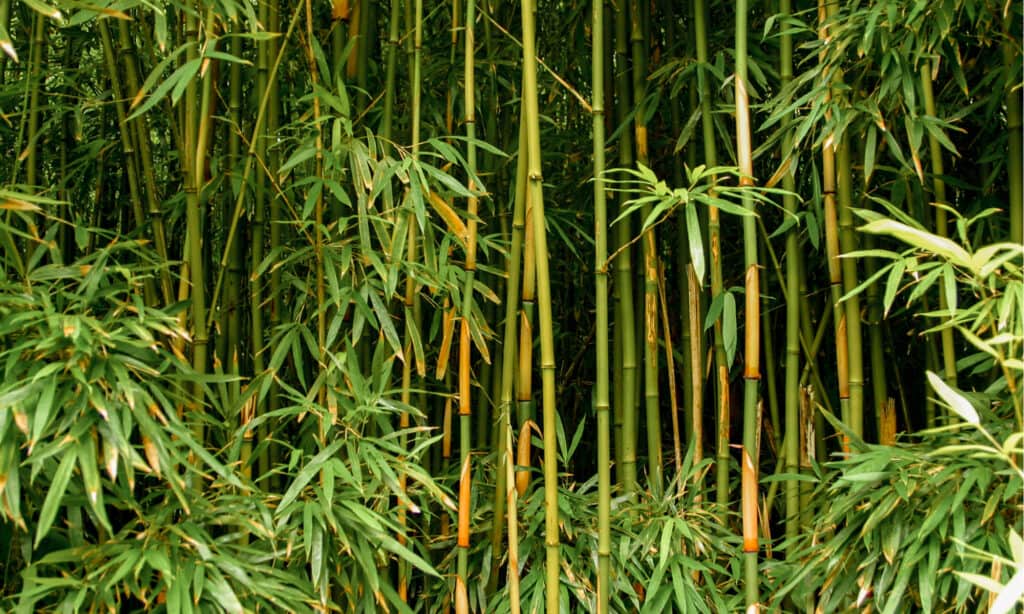Growing healthy bamboo is rewarding. It not only adds refreshing visual interest to an outdoor space but can provide shade and privacy as well. If you’re considering growing bamboo in your yard or home garden, knowing how to keep your bamboo vibrant and healthy will set you up for success and ensure years of botanical beauty in your landscape.
In this guide, we’ll cover some of the critical points to consider when choosing and planting bamboo and make sure you have the foundational knowledge to help your plants thrive.
How to Grow Healthy Bamboo
Bamboo plants are incredibly diverse. They can grow in environments that range from humid and tropical to temperate and mountainous. Some can even survive temperatures as low as -20 degrees Fahrenheit. With so much diversity, it may be surprising that many species of bamboo in cultivation have fairly similar care requirements.
That being said, however, is important to know what your specific bamboo cultivar needs to thrive. Let’s look at the factors you’ll need to consider in order to help your plants look and feel their best.
Choose the Right Type
The first step toward ensuring that your bamboo plant is healthy is to know which type you have. There are two main types of bamboo that each grow in different ways and prefer different climates. The first type, the running type bamboo, is a temperate species. They tend to be more cold-hardy and are faster spreading than other bamboo species. Because of this, it is often a good idea to limit their ability to spread.
The second type, the clumping bamboo, is almost always tropical or subtropical species and generally does not tolerate cold temperatures. Clumping-type bamboo species grow much more slowly than the running type, forming tight, densely-packed clumps or columns of growth. Due to their slow-spreading nature, these bamboo species do not usually need to be contained.
Knowing which type your plant belongs to is crucial, as it allows you to ensure that you choose a bamboo species that is suited to your growing zone. It will also help you to pick the correct planting site for your new bamboo and decide on a containment strategy if necessary. Several other factors, like your cultivar’s maximum height, watering needs, and sunlight requirements, should influence where you plant your bamboo as well. While bamboo is adaptable and versatile, it is important to account for these factors ahead of time to ensure that your bamboo stays healthy.
Sunlight
Sunlight requirements will vary between cultivars. Some species, like the dwarf whitestripe bamboo, prefer only a few hours of sunlight per day. Others, like the giant timber bamboo, grow incredibly tall and require many hours per day of direct sunlight to ensure that they can produce enough nutrients to support such large growth.
If you are growing your bamboo plant indoors, situating it near a south-facing window can help it receive enough sunlight over the course of the day.

Dwarf whitestripe bamboo can be grown indoors and prefers only a few hours of sunlight daily.
©Toibkk/Shutterstock.com
Water
While some bamboo, like many Phyllostachys species, is very drought tolerant, most bamboos require a lot of water to really thrive. In order for your plants to produce their best growth, you will need to make sure that their soil is consistently moist. As your bamboo plants expand outward and produce new culms, they are able to help you do this by keeping their own root zones cool and shady. This helps prevent evaporation.
Be careful when watering your plants, however. Most bamboo is especially sensitive to overwatering and can quickly suffocate if standing water is allowed to accumulate. That being said, it is crucial to choose a planting site that does not allow for pooling.
If your bamboo plant is growing in a pot rather than in the ground, be sure that its container has drainage holes. Also, remember that it will need to be watered more frequently than it would if it were in the ground. Because pots have limited soil mass and tend to be porous, the soils they contain tend to dry out more quickly.

While some bamboo is very drought tolerant, most bamboos require a lot of water to really thrive.
©Eric Patterson/Shutterstock.com
Soil Conditions
Many species of bamboo tend to be versatile with regard to the type of soil they will accept. This is great for the gardener, as that means that growing healthy bamboo is achievable in a wide variety of environments. In order to give your bamboo the best possible soil conditions, though, some amendments may be necessary.
As a general rule, bamboo prefers soil that is nutritive, slightly acidic, and well-draining. Sandy loam is ideal in most cases. When planting your bamboo in the garden, it is generally a good idea to turn some compost or well-rotted animal manure into the dirt before it is returned to the hole with your plant. This practice can help break up heavy soils, aid in moisture retention, and improve drainage. It also helps to increase the pore size of your soil, allowing oxygen to penetrate deeper into the ground.
The addition of a mulch layer is important as well, especially when soils have been disturbed. Mulching prevents your soil from sun exposure, which kills off the sensitive microbial communities that control decomposition and the exchange of nutrients in the soil. It also helps to cushion against compaction and retain moisture while still allowing oxygen to reach your plants’ roots. In order for your bamboo plants to remain healthy, it is of utmost importance that you also keep your soil as healthy as possible.
The photo featured at the top of this post is © iStock.com/LianeM
Thank you for reading! Have some feedback for us? Contact the AZ Animals editorial team.







